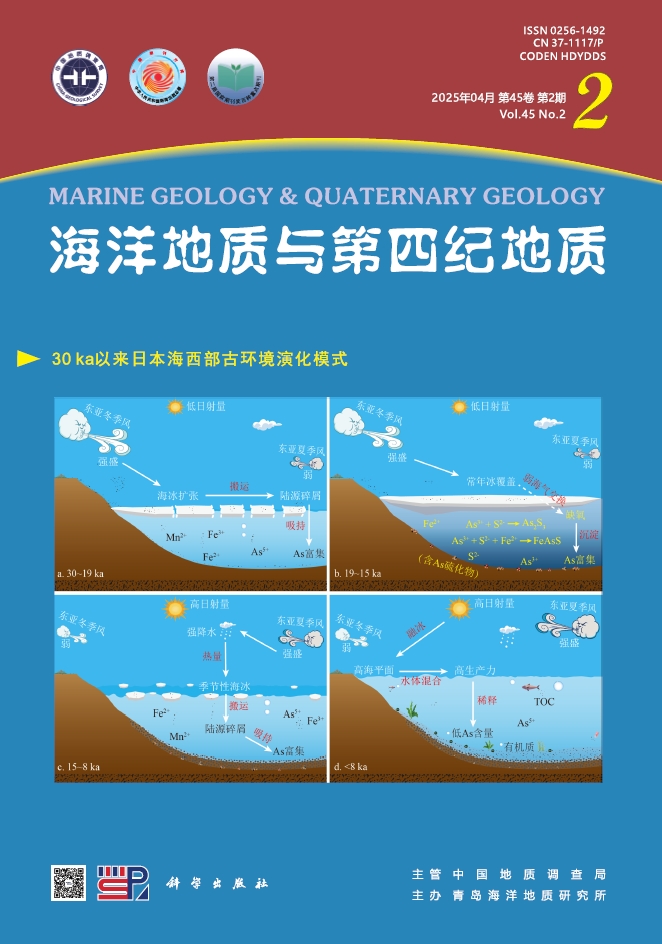| [1] |
Villareal T A, Abundance of the giant diatom Ethmodiscus in the Southwest Atlantic Ocean and Central Pacific Gyre[J]. Diatom Research, 1993, 8:171-177.
Google Scholar
|
| [2] |
Kemp A E S, Pike J, Pearce R B, et al. The "Fall dump"——a new perspective on the role of a "shade flora" in the annual cycle of diatom production and export flux[J]. Deep-Sea Res Part Ⅱ, 2000, 47:2129-2154.
Google Scholar
|
| [3] |
翟滨,李铁刚,熊志方,等. 末次冰期低纬度西太平洋硅藻席沉积中的硅藻记录[J]. 热带海洋学报, 2012,31(4):75-82.
Google Scholar
[ZHAI Bin, LI Tiegang, XIONG Zhifang, et al. Diatom records inferred from the diatom mat deposits from low-latitude Western Pacific in the last glacial period[J]. Journal of Tropical Oceanography, 2012, 31(4):75-82.]
Google Scholar
|
| [4] |
Zhai Bin, Li Tiegang, Chang Fengming, et al. Vast laminated diatom mat deposits from the west low-latitude Pacific Ocean in the last glacial period[J]. Chin Sci. Bull.,2009, 54:4529-4533.
Google Scholar
|
| [5] |
Juggins S. C2 User Guide, Software for Ecological and Palaeoecological Data Analysis and Visualization[M]. Newcastle upon Tyne, UK, University of Newcastle, 2003.
Google Scholar
|
| [6] |
Jiang H, Zheng Y, Ran L, et al. Diatoms from the surface sediments of the South China Sea and their relationships to modern hydrography[J]. Marine Micropaleontology, 2004,53(3-4):279-292.
Google Scholar
|
| [7] |
Hasle G R, Syvertsen E E. Marine diatoms[M]//In:Identifying Marine Phytoplankton. Academic Press, California, 1997.
Google Scholar
|
| [8] |
Hendey N. An introductory account of the smaller algae of British coastal water, Part V:Bacillariophyceae (diatoms)[M]. Fishery Investigations London Series. London:H M Stationery Office, 1964:74-165.
Google Scholar
|
| [9] |
Tanimura Y. Varieties of a single cosmopolitan diatom species associated with surface water masses in the North Pacific[J]. Marine Micropaleontology, 1999,37(2):199-218.
Google Scholar
|
| [10] |
Koizumi I, Irino T, Oba T. Paleoceanography during the last 150 kyr off central Japan based on diatom floras[J]. Marine Micropaleontology, 2004,53(3-4):293-365.
Google Scholar
|
| [11] |
Jousé A, Kozlova O, Muhina V. Distribution of diatoms in the surface layer of sediment from the Pacific Ocean[M]//Micropaleontology of Oceans. Cambridge University Press, 1971:263-269.
Google Scholar
|
| [12] |
Ignatiades L, Georgopoulos D, Karydis M. Description of the phytoplanktonic community of the oligotrophic waters of the SE Aegean Sea (Mediterranean)[J]. Marine Ecology, 1995, 16(1):13-26.
Google Scholar
|
| [13] |
Wiseman J D H, Hendey N I. The significance and diatom content of a deep-sea floor sample from the neighborhood of the greatest oceanic depth[J]. Deep-Sea Research, 1953,1, 47-59.
Google Scholar
|
| [14] |
Gardner J V, Burckle L H. Upper Pleistocene Ethmodiscus rex oozes from the eastern equatorial Atlantic[J]. Micropaleontology, 1975, 21:236-242.
Google Scholar
|
| [15] |
Yoder J A, Ackleson S G, Barber R T, et al. A line in the sea[J]. Nature, 1994, 371:689-692.
Google Scholar
|
| [16] |
Zhifang Xiong, Tiegang Li, Xavier Crosta, et al. Potential role of giant marine diatoms in sequestration of atmospheric CO2 during the Last Glacial Maximum:δ13C evidence from laminated Ethmodiscus rex mats in tropical West Pacific[J]. Global and Planetary Change, 2013,108:1-14.
Google Scholar
|
| [17] |
Sprintall J, Tomczak M. Evidence of the barrier layer in the surface layer of the tropics[J]. Journal of Geophysical Research, 1992, 97(C5):7305-7316.
Google Scholar
|






 DownLoad:
DownLoad: